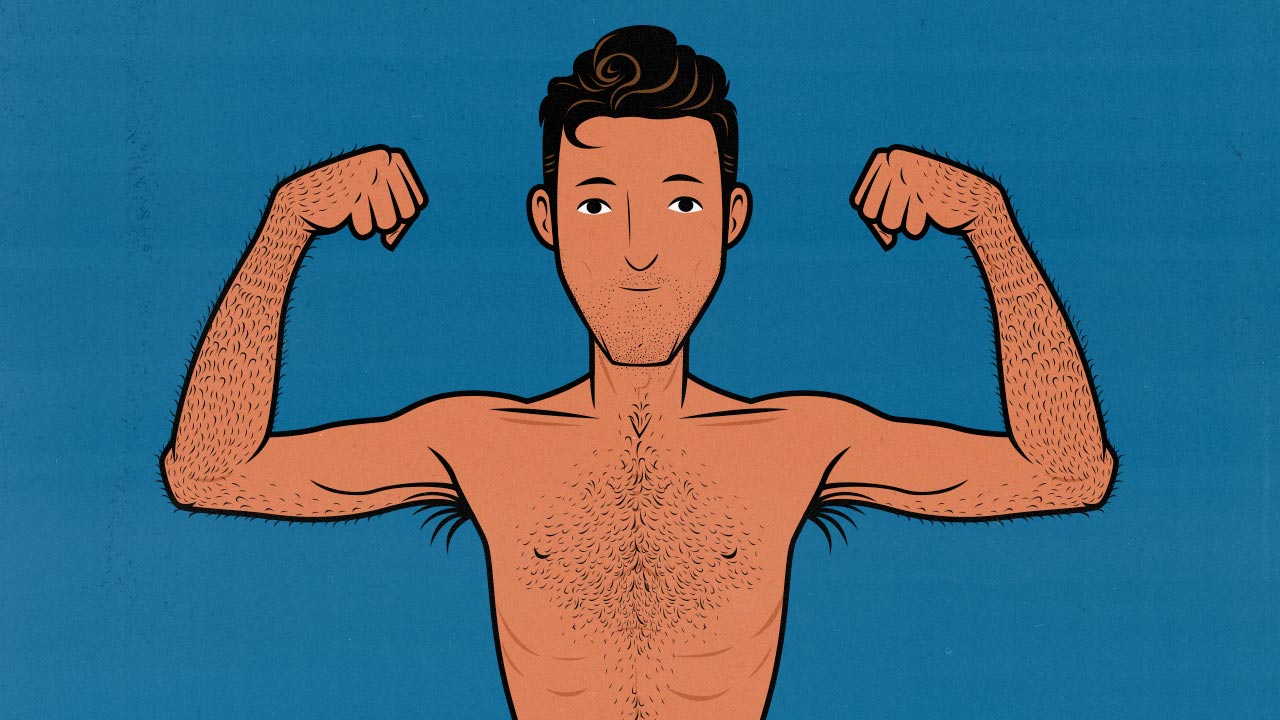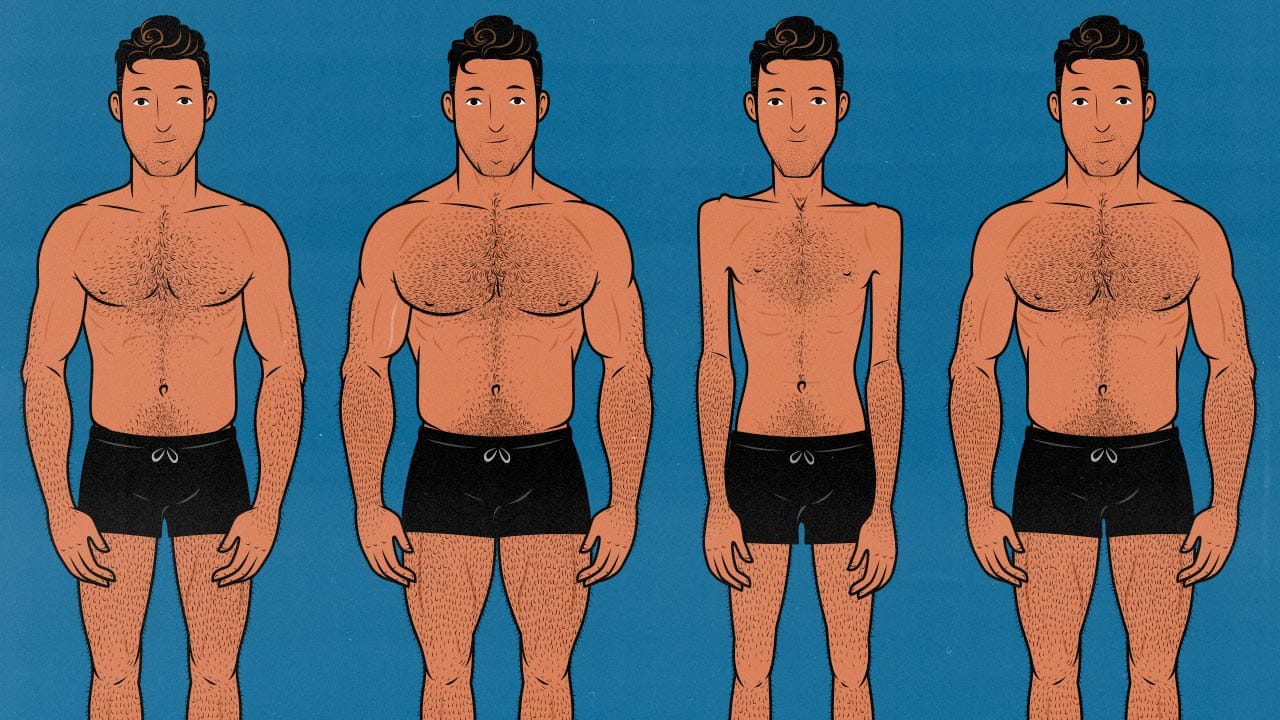Articles
How to Eat More Calories, Increase Your Appetite & Gain Weight
Most naturally thin people struggle to eat enough calories to gain weight. Usually, that’s a good thing. Our genetics help us avoid the obesity that plagues almost everyone else.
But if you’re skinny, underweight, or trying to bulk up, then the same genetic advantages that keep you healthfully lean can also make it extremely difficult to eat enough calories to build muscle.
Gaining weight is difficult, but it isn’t impossible, and we can make it much easier. I’ve gained 70 pounds and comfortably maintained it for over a decade. We’ve also helped over fifteen thousand other naturally skinny people bulk up, including professional and Olympic athletes. We’ve learned quite a lot while doing it.
I’ve got 17 tips that will make it much easier to gain weight.
Read MoreWhat’s an Ectomorph? Are Body Types Even Real?
An ectomorph is someone who is naturally slim. We tend to have thinner bone structures, fewer fat cells, and faster metabolisms. We’re often taller than average, with longer spines and limbs and proportionally smaller stomachs.
I’m an ectomorph. I’ve also spent the past fifteen years helping other ectomorphs gain weight, build muscle, and improve their health. It isn’t a body type. Some of our clients have included college, professional, and Olympic athletes. You can do great things with it.
Still, ectomorph is a controversial word. It was coined by the disgraced psychologist William Herbert Sheldon in the 1940s. He used it to describe the skinny body type and personality type, but he couldn’t prove a link between the two.
So, the word ectomorph isn’t scientific, but many of us still use it because it’s the simplest way to describe our thin builds.
Read MoreIs Intermittent Fasting Good for Bulking & Building Muscle?
Intermittent fasting is popular for weight loss. But what if you’re a skinny guy trying to bulk up? Can you use intermittent fasting to build muscle faster or more leanly? After all, intermittent fasting raises growth hormone production, which purportedly helps with muscle growth; it increases insulin sensitivity, which could help make your muscle gains leaner; and research shows that intermittent fasting may help preserve muscle when losing weight.
On the other hand, bodybuilders are known for eating frequently—every few hours. They eat more often than the average person. Why is that? Could there be an advantage to eating more meals more often?
Finally, does intermittent fasting make it harder to eat enough calories to gain weight? Skinny guys are notorious for having smaller stomachs, faster metabolisms, and more meagre appetites, all of which can make it harder to eat enough calories to gain weight. Will intermittent fasting make that even harder?
Read MoreCan You Build Muscle On Keto? Most Research Says You Can’t
People have been using keto to lose weight for the past 200 years. For example, in the 1970s, it saw a surge in popularity because of the Atkins Diet, which started with a strict ketogenic phase.
During that same time period, bodybuilders have leaned towards higher-carb diets. Conventional bulking diets get most of their calories from carb-rich foods like rice, potatoes, sweet potatoes, oats, bananas, yogurt, beans, and lentils.
What happens if you try to use a ketogenic diet to build muscle? Will it hinder muscle growth? Can it yield leaner gains?
Dive inWhy Am I So Skinny? Skinny Genetics Explained
I’m naturally skinny. Both of my parents were, too. My dad was nicknamed “Mop” because of his shaggy hair and stick-thin body. My mum was nicknamed “Lampshade” because of her bob haircut and flat figure.
In my early twenties, I weighed 125 pounds at 6’2, with a BMI of 16. That’s clinically underweight, and my doctor never let me forget it. Nobody did. So, I dove deep down the rabbit hole of trying to figure out why I was so much skinnier than everyone else I knew.
There are a few genetic factors that make some people naturally skinny. We often have thinner bones, fewer fat cells, faster metabolisms, smaller stomachs, and a different hormonal response to food. Sometimes, our organs work a little harder than usual, burning extra calories. I’ll go into all of this in a second.
None of those genetic traits make it impossible to gain weight. There are several solutions for all of them. It’s just that while most people gain weight by accident, we need to do it on purpose. Having skinny genetics also comes with several huge advantages. I’ll cover those, too.
It took me a little over a year to bulk to a healthy body weight. I blogged about how I gained 70 pounds, teamed up with a renowned strength coach, and have spent the past 15 years helping other skinny people understand their genetics, build muscle, and improve their health.
Read MoreDo Smoothies Cause Weight Gain?
Most research shows that calories are less filling when you drink them, making it easier to gain weight (systematic review). Maybe that’s because you don’t need to chew, you don’t spend as long eating, and the food doesn’t stay in your stomach as long (study, study, study).
Smoothies aren’t like soda and juice, though. They’re made by blending nutritious whole foods. For example, when you blend fruits with seeds in them (like berries), you release more of the fibre, slowing digestion and blunting the blood sugar response (study). Perhaps that keeps you feeling full for longer, causing you to eat fewer calories.
Also, before going into the research, I should note that there’s nothing fattening or unhealthy about smoothies. Smoothies can be incredibly nutritious. Blending up food doesn’t make it more likely to be stored as fat, but it might make us more likely to eat more food, tipping us into a calorie surplus.
Read MoreHow Many Sets Should You Do Per Muscle Group Per Week?
The latest meta-analysis suggests you can maximize your rate of muscle growth with 10–20 sets per muscle group per week (Baz-Valle). That means in certain circumstances, you can expect to build as much muscle with 10 sets as 20. In other circumstances, going up to 20 sets could stimulate extra muscle growth. Going past 20 probably won’t stimulate even more.
This is a contentious topic. Some people believe it’s better to train harder, for fewer sets, less often. Others believe that there’s no real volume ceiling—that you can benefit from as many sets as you can suffer through.
Right now, the most famous programs use a moderate training volume (of about 8–24 sets per muscle per week), the research supports a moderate training volume, and most experts recommend a moderate training volume (exhaustive breakdown here). It’s also the approach we use when training clients ranging from desk workers all the way up to professional and Olympic athletes.
However, there are quite a few assumptions baked into these set recommendations.
- You’re training for hypertrophy. That means choosing good exercises, using a deep range of motion, doing about 6–20 reps per set, resting at least 2 minutes between sets, and taking your sets to within 3 reps of failure.
- You’re training all the major muscle groups in your body. If we look at studies where people are only training some muscles, then they can usually handle much higher training volumes. For example, the recent Enes study found that people could work up to 52 sets of quad exercises per week, but they were only training their quads.
- The exercise does a good job of working the muscle you’re trying to grow. For example, rows aren’t ideal for the long heads of your biceps, bench presses aren’t great for the long head of your triceps, and deadlifts aren’t the best for the long head of your hamstrings. You’d want to target those muscles with isolation exercises.
- You work up to the volume gradually. A good workout program starts with a lower training volume and gradually works its way higher. For example, you might start with 2 sets per exercise and work your way up to 5 over 4–8 weeks. That saves you from crippling soreness in the early weeks, and it keeps the challenge high in the later weeks. It also builds more muscle (study, study).
That gives us a few things to talk about and a few interesting examples to go over.
Read MoreDoes Blending Fruits Affect Their Fibre, Nutrients, or Sugar?
I’ve been asked a few times whether it’s healthy to blend fruits into smoothies. Usually, the concern is that blending breaks down the cellular structure of the fruit, releasing more sugar into your bloodstream and spiking your blood sugar. The opposite is true. I’ll explain that in a second.
Another concern is that blending fruits destroys the fibre or nutrients. Blending doesn’t usually destroy anything, and sometimes it releases extra nutrients, but there’s one situation to watch out for. It might be bad to blend bananas with blueberries, kind of.
Read MoreHow to Build a Bigger Back: The Best Back Exercises & Workout
You can build a bigger back by doing a mix of horizontal pulls, vertical pulls, and deadlifts. Your back is made up of layers of overlapping muscles, all of which can work together, but many of which have different functions.
You could divide your back into your upper back (traps, rear delts, rhomboids, and teres major) and lower back (lats and spinal erectors), but even within the same back muscle, different regions respond better to different exercise variations. For example, your upper lats have a slightly different function from your lower lats.
You train your upper back and lats by combining vertical pulls (like chin-ups) with horizontal pulls (like rows). Adding a deadlift variation will take care of your lower back, giving you a thicker back. But it also helps to consider whether you’re tucking or flaring your elbows and whether you’re stretching and contracting your shoulder blades.
Delve DeeperHow to Build an Aesthetic Physique
Most men want to have an aesthetic physique. Few know exactly what that means. For example, when they guess the degree of muscularity women prefer, they’re off by thirty pounds (study). Many have a deeper misunderstanding, failing to connect their appearance to their fitness and strength. Some shun aesthetics, mistakenly thinking it’s superficial. Others are superficial on purpose, thinking it’s the best way to become attractive. That’s never as convincing as the real thing.
We’ll cover the attractiveness research. We’ve spoken to some of the study authors. We also went deeper, testing our hypotheses by conducting our own surveys. We collected thousands of responses for each: survey 1 and survey 2.
But be warned: this article is long. If you don’t want to read the whole thing, here’s a simple trick to improve your appearance: have a drink. It will boost your aesthetics (to yourself) by 50%. This is called “The Reverse Beer Goggles Effect,” also known as Beauty is in the Eye of the Beer Holder (study). It’s not a perfect solution, but it will save you twenty minutes of reading.
Read More









